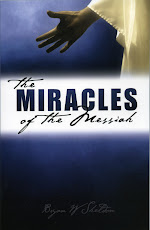The Messiah and the Abrahamic Covenant.
The Abrahamic Covenant was very wide ranging. Through Abraham it promised three main benefits – blessings (which must be assumed to be both spiritual and material), a multi-national posterity and a homeland for the Hebrew nation. All this was to be achieved through a ‘seed’, a line that would be fathered by Abraham and continue through his son Isaac and his grandson Jacob. The Land Covenant elucidated further the Jewish homeland element in the Abrahamic covenant (including the material blessings that would accrue to the inhabitants); the Davidic Covenant brought a further limiting element to the ‘seed’ aspect in conjunction with promising wide ranging influence; while the New Covenant identified the spiritual section of the blessings promised.
The Covenant Summarized
Any Messianic claimant would need to have the appropriate ancestry – of the seed of Abraham, Isaac, Jacob, of the tribe of Judah Israel Judah
There has never been any question that Jesus was a Jew, a true son of Abraham.[6] He was circumcised on the eighth day[7] and redeemed according to the Law.[8] Both his mother and step-father were Hebrews with a long and honorable lineage. In addition, His dress, His actions, His teaching, all testify to the thorough Jewishness of His person. He was law abiding in the sense that not only did He act in a responsible manner as a member of the community but He also did what was required to fulfill the Law of Moses. There are some Scriptures that teach us that He wore the appropriate clothes. In the episode where a woman needed a healing touch, she decided that if she could reach the hem of His garment she should be cured. The Greek word is ‘kraspedon’ sometimes translated ‘fringe’. The Hebrew equivalent is ‘zizith’. What is in view here are the fringes woven on to the outer garment that was worn by Jewish men. These fringes were four blue tassels worn in obedience to the injunction of the Law in Numbers 15:37–41 and Deuteronomy 22:12. Matthew again refers to them in 14:36 and 23:5. They consisted of four threads passing through the four corners of the garment and meeting in eight. One of the threads was longer than the others. It was twisted seven times round the others, and a double knot formed; then eight times, then eleven times, then thirteen times. The thread and the knots stood for the five books of the Law. The idea of the fringe was two-fold. It was meant to identify a Jew as a Jew and as a member of the chosen people, no matter where he was; and it was meant to remind a Jew every time he put on and took off his clothes that he belonged to God. Jesus had these fringes on His clothes.
We also know that He celebrated the feasts according to the instructions laid down in the Pentateuch. We have record of His visits to Jerusalem for Passover and the Feast of Unleavened Bread and we know He attended the Temple
So it was that Jesus was the ‘fulfillment’ of all that the Law was designed to accomplish. He was the only fully, Law abiding Hebrew that ever lived, and therefore the only One who could ultimately deliver the Jewish nation from the bondage of the Law.
There is a yet more vital element to this aspect of the proper lineage. Others also claimed to be descendents of Abraham but Jesus added yet one more qualification. Only those who did the will of God could be counted a true descendent of Abraham. John the Baptist implied it first. He said, “do not think to say to yourselves, ‘We have Abraham as our father.’ For I say to you that God is able to raise up children to Abraham from these stones”. (Matt. 3:9; Luke 3.8) In other words, he indicated that the proper ancestry was insufficient in itself; they needed to be fulfilling the revealed will of God, which, in the context of the Baptist’s preaching, was to repent and receive Jesus as their Messiah. The essence of this is repeated in the debate between Jesus and His Jewish listeners in John 8.38-45. But the will of God for the Messiah was to complete the mission for which He had been commissioned. This means that there could only have been one claimant to the title of Messiah, the One sent by the Father.
What is the sum of this? that if Jesus’ claim to be the Messiah is to be upheld, He not only had to have the right lineage but also has be a faithful Son of Abraham and do the will of God. This He did. He said, “I do not seek My own will but the will of the Father who sent Me”. (John 5:30) and, “My food is to do the will of Him who sent Me, and to finish His work”. (John 4:34) That He was successful is evident. In His life He had the confirmation by the three Bat Kohls, the essence of which was, “This is My beloved Son, in whom I am well pleased.” (Matt. 3:17; cf. 17.5; Mark 1.11; 9.7; Luke 3.22; 9.35; John 12.27,28). And after His death He had the vindication of the resurrection for it was God who raised Him from the dead.[9]
More Next Time:
[1] Jer.22.24-30
[2] Isa.7.14 ; Matt.1.23
[3] Gal.3.16; Heb.2.16
[4] Also called ‘seed’ in Acts 13.22,23; Rom.1.3; 1 Tim.2.8; but ‘Son of David’ in Matt. 1.1; 9.27; 12.23; 15.22; 20.30,31; 21.9,15; Mark 10.47,48; Luke 3.31; 18.38,39;
[5] Matt.8.29; 14.33; 27.54; Mark 1.1; 3.11; 15.39; Luke 1.35; 4.41; 8.28; John 1.34; 1.49; 3.18; 9.35-37; 11.27; 20.31; Acts 8.37; 9.20; Rom.1.4; 2 Cor.1.19; Eph.4.13; Heb.4.14; 1 John 4.15; 5.5,10; Rev.2.18
[6] Matt.1.1
[7] Luke 2.21
[8] Luke 2.22
[9] Acts 13.30, 34; 17.31; Rom.10.9; Gal.1.1; Eph.1.20; Col.2.12; 1 Pet.1.21






No comments:
Post a Comment